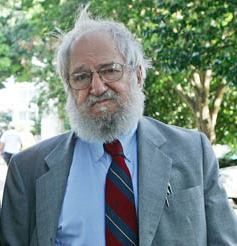Related Research Articles
Educational psychology is the branch of psychology concerned with the scientific study of human learning. The study of learning processes, from both cognitive and behavioral perspectives, allows researchers to understand individual differences in intelligence, cognitive development, affect, motivation, self-regulation, and self-concept, as well as their role in learning. The field of educational psychology relies heavily on quantitative methods, including testing and measurement, to enhance educational activities related to instructional design, classroom management, and assessment, which serve to facilitate learning processes in various educational settings across the lifespan.

Learning theory describes how students receive, process, and retain knowledge during learning. Cognitive, emotional, and environmental influences, as well as prior experience, all play a part in how understanding, or a worldview, is acquired or changed and knowledge and skills retained.
A teaching method is a set of principles and methods used by teachers to enable student learning. These strategies are determined partly on subject matter to be taught and partly by the nature of the learner. For a particular teaching method to be appropriate and efficient it has take into account the learner, the nature of the subject matter, and the type of learning it is supposed to bring about.
Instructional scaffolding is the support given to a student by an instructor throughout the learning process. This support is specifically tailored to each student; this instructional approach allows students to experience student-centered learning, which tends to facilitate more efficient learning than teacher-centered learning. This learning process promotes a deeper level of learning than many other common teaching strategies.
In psychology, cognitivism is a theoretical framework for understanding the mind that gained credence in the 1950s. The movement was a response to behaviorism, which cognitivists said neglected to explain cognition. Cognitive psychology derived its name from the Latin cognoscere, referring to knowing and information, thus cognitive psychology is an information-processing psychology derived in part from earlier traditions of the investigation of thought and problem solving.
Situated learning is a theory that explains an individual's acquisition of professional skills and includes research on apprenticeship into how legitimate peripheral participation leads to membership in a community of practice. Situated learning "takes as its focus the relationship between learning and the social situation in which it occurs".

Active learning is "a method of learning in which students are actively or experientially involved in the learning process and where there are different levels of active learning, depending on student involvement." Bonwell & Eison (1991) states that "students participate [in active learning] when they are doing something besides passively listening." According to Hanson and Moser (2003) using active teaching techniques in the classroom can create better academic outcomes for students. Scheyvens, Griffin, Jocoy, Liu, & Bradford (2008) further noted that "by utilizing learning strategies that can include small-group work, role-play and simulations, data collection and analysis, active learning is purported to increase student interest and motivation and to build students ‘critical thinking, problem-solving and social skills". In a report from the Association for the Study of Higher Education, authors discuss a variety of methodologies for promoting active learning. They cite literature that indicates students must do more than just listen in order to learn. They must read, write, discuss, and be engaged in solving problems. This process relates to the three learning domains referred to as knowledge, skills and attitudes (KSA). This taxonomy of learning behaviors can be thought of as "the goals of the learning process." In particular, students must engage in such higher-order thinking tasks as analysis, synthesis, and evaluation.
Learning styles refer to a range of theories that aim to account for differences in individuals' learning. Although there is ample evidence that individuals express personal preferences on how they prefer to receive information, few studies have not found any validity in using learning styles in education. Many theories share the proposition that humans can be classified according to their "style" of learning, but differ on how the proposed styles should be defined, categorized and assessed. A common concept is that individuals differ in how they learn.

Constructivism is a theory in education which posits that individuals or learners do not acquire knowledge and understanding by passively perceiving it within a direct process of knowledge transmission, rather they construct new understandings and knowledge through experience and social discourse, integrating new information with what they already know. For children, this includes knowledge gained prior to entering school. It is associated with various philosophical positions, particularly in epistemology as well as ontology, politics, and ethics. The origin of the theory is also linked to Swiss developmental psychologist Jean Piaget's theory of cognitive development.
A KWL table, or KWL chart, is a graphical organizer designed to help in learning. The letters KWL are an acronym, for what students, in the course of a lesson, already know, want to know, and ultimately learn. It is a part of the constructivist teaching method where students move away from what are considered traditional methods of teaching and learning. In this particular methodology the students are given the space to learn by constructing their own learning pace and their own style of understanding a given topic or idea. The KWL chart or table was developed within this methodology and is a form of instructional reading strategy that is used to guide students taking them through the idea and the text. A KWL table is typically divided into three columns titled Know, Want and Learned. The table comes in various forms as some have modified it to include or exclude information.

Constructionist learning is the creation by learners of mental models to understand the world around them. Constructionism advocates student-centered, discovery learning where students use what they already know, to acquire more knowledge. Students learn through participation in project-based learning where they make connections between different ideas and areas of knowledge facilitated by the teacher through coaching rather than using lectures or step-by-step guidance. Further, constructionism holds that learning can happen most effectively when people are active in making tangible objects in the real world. In this sense, constructionism is connected with experiential learning and builds on Jean Piaget's epistemological theory of constructivism.
A lesson plan is a teacher's detailed description of the course of instruction or "learning trajectory" for a lesson. A daily lesson plan is developed by a teacher to guide class learning. Details will vary depending on the preference of the teacher, subject being covered, and the needs of the students. There may be requirements mandated by the school system regarding the plan. A lesson plan is the teacher's guide for running a particular lesson, and it includes the goal, how the goal will be reached and a way of measuring how well the goal was reached.
This glossary of education-related terms is based on how they commonly are used in Wikipedia articles. This article contains terms starting with T – Z. Select a letter from the table of contents to find terms on other articles.

Discovery learning is a technique of inquiry-based learning and is considered a constructivist based approach to education. It is also referred to as problem-based learning, experiential learning and 21st century learning. It is supported by the work of learning theorists and psychologists Jean Piaget, Jerome Bruner, and Seymour Papert.
E-learning theory describes the cognitive science principles of effective multimedia learning using electronic educational technology.
The gradual release of responsibility (GRR) model is a particular style of teaching which is a structured method of pedagogy framed around a process devolving responsibility within the learning process from the teacher to the eventual independence of the learner. This instructional model requires that the teacher, by design, transitions from assuming "all the responsibility for performing a task...to a situation in which the students assume all of the responsibility". The ideal result is a confident learner who accepts responsibility for their own learning and directs this learning through the cognitive processes involved, moving through the academic spectrum, to independent choice. As Buehl (2005) stated, the GRR model "emphasizes instruction that mentors students into becoming capable thinkers and learners when handling the tasks with which they have not yet developed expertise".
Constructivism has been considered as a dominant paradigm, or research programme, in the field of science education since the 1980s. The term constructivism is widely used in many fields, and not always with quite the same intention. This entry offers an account of how constructivism is most commonly understood in science education.
The Cognitive Theory of Inquiry Teaching, also referred to as the Cognitive Theory of Interactive Teaching, was developed by Allan Collins and Albert L. Stevens. Allan Collins was a chief scientist at Bolt Beranek and Newman Inc., a research firm in Cambridge Massachusetts. He is also a specialist in the field of cognitive science and human semantic processing. Albert L. Stevens was a senior scientist at Bolt Beranek and Newman Inc. He was also director of the company's Artificial Intelligence, Education Technology and Training Systems Division. He is also a specialist in cognitive science. The Cognitive Theory of Inquiry Teaching according to Collins and Stevens (1981) requires the learner to construct theories and principles through dialogue, the teaching of self-questioning techniques and the teaching of metacognitive or self-monitoring skills, all with the intent of clarifying misconceptions so the theory or principle is well articulated and developed. The essence of the cognitive theory of Inquiry teaching is that of developing students' metacognitive skills. Inquiry teaching deliberately attempts to develop these stills through instruction.

Professor John Downing, an educational psychologist, proposed the cognitive clarity theory of learning to read in a paper which he presented to the annual meeting of the United Kingdom Literacy Association between the 23rd and 28th of July, 1971.
Annemarie Sullivan Palincsar is a scholar of education known for her research on literacy instruction, reciprocal teaching, and cognitive apprenticeships. Her involvement in the National Academies of Sciences, Engineering, and Medicine Research Council on the Prevention of Reading Difficulty in Young Children, the National Research Council's Panel on Teacher Preparation, and the International Literacy Association's Literacy Research Panel, attests to her dedication to advancing educational research and improving teacher training. Palincsar is the Ann L. Brown Distinguished University Professor Emerita at the Marsal Family School of Education at the University of Michigan.
References
- ↑ "King's College London - Cognitive Acceleration (CASE and other projects)". 2012. Archived from the original on 15 November 2013. Retrieved 16 March 2012.
- ↑ Adey, P. S..(1993). Accelerating the development of formal thinking in Middle and High school students IV: three years on after a two-year intervention . Journal of Research in Science Teaching, 30, 4, 351-366.
- ↑ Adhami, M., Robertson, A., & Shayer, M.(2004). Let's Think Through Maths!: Developing thinking in mathematics with five and six-year-olds. London: nferNelson
- ↑ Times Educational Supplement Magazine storyline 379714
- ↑ "Theory and pedagogy". 2012. Archived from the original on 8 January 2014. Retrieved 16 March 2012.